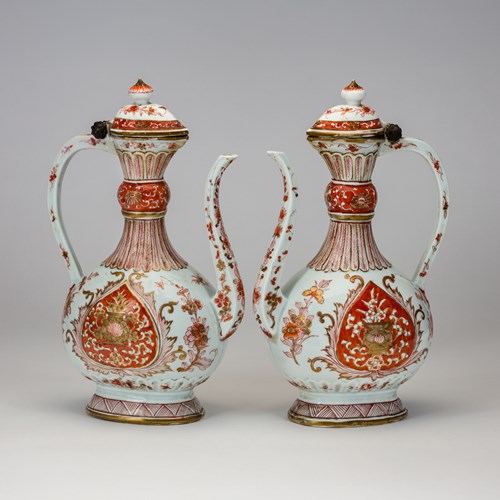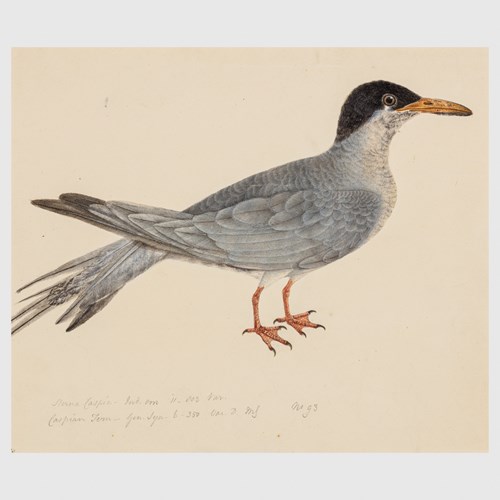Marketplace
Ladies by a Swing
Ladies by a Swing
Date c. 1800
Period Early 19th century
Origin Western India (or Canton, China)
Dimension 40 x 34 x 44 cm (15³/₄ x 13³/₈ x 17³/₈ inches)
Reverse glass painting in original Chinese gilt frames in the style of Louis XVI.
A woman is pushing another on a swing amidst a landscape of trees and hills. The first woman wears a very fine, diaphanous costume with striped pyjamas underneath and slippers on her feet. A hat with a plume which is very similar to hers, is depicted on a c. 1660 casket from Golconda, India (Victoria and Albert Museum, 851-1889). The other woman is similarly bejewelled and clad, but she is barefoot, her slippers neatly placed on the ground. The swing is suspended from the branch of a pine tree and there is a lake in the background; both the pine, a symbol of longevity, and the lake are often-seen features in 18th century Chinese reverse glass paintings. The small tree with the sprouting branches on the left may be compared stylistically to that in a Chinese export watercolour, dated to c. 1785 (Victoria and Albert Museum, D. 1085-1898). There are also influences from European painting: the rolling hills and the shrubs in muted colours are typical of the pastoral scenes of the 18th century. The lake is light grey, the white on its surface denoting the reflection of the clouds. These types of clouds would have been unknown in Chinese or Indian painting tradition and were transposed from European paintings. Added to the fusion of Chinese and European landscape elements are the figures dressed in an Indian fashion but with non-Indian physiognomic features including the light pink skin colour. The subject matter of a female on a swing, pushed by another is found in Indian miniature paintings. The build-up of the clouds seems to allude to the longing for the monsoon, with an underlying meaning of separation from the beloved. The artist has used a simple perspective where the mountains in the background fade at the horizon.
Part of A Series of Reverse Glass Paintings.
These six reverse glass paintings were produced by Chinese artists for an elite Indian clientele. There was not only a high demand for Chinese reverse glass paintings in Europe and America, but they were also exported from the mid-18th century onwards to the west coast of India by Parsi traders. By the late-18th century Chinese commercial artists had settled in western India to produce such paintings. These included Chinese artists who were employed at the royal courts of the princely states, for example, Kutch and Mysore.
The reverse glass painting technique originated in 15th–16th century Europe, and it is thought that Jesuit missionaries introduced it to China, where reverse glass paintings were made as early as the 1730s. They became very popular in the Chinese export art trade, which began in the 18th century and reached its height between 1800–1850, catering for the demand in the West for paintings and porcelain made in China. Guangzhou (Canton) was the centre of production for export art, including reverse glass paintings.
In export art, the Chinese artists applied European visual representation together with Chinese artistic features. Thus, the end result was a hybrid product made to meet Western demand and taste for the exotic but with some familiar characteristics to the intended viewer. As the term implies, in reverse glass paintings, the artist paints the image in reverse on the back of a sheet of glass, using a master drawing to transpose the outline, to which colours were applied, beginning with any shading and highlighting and followed by the body colour. At the end of the process, the glass is turned over and the finished picture is viewed from the front, unpainted side of the glass.
References:
Audric, Thierry. Chinese Reverse Glass Painting 1720–1820: An Artistic Meeting Between China and the West. Peter Lang, London. 2020.
Clunas, Craig. Chinese Export Watercolours, Victoria and Albert Museum, London. 1984.
Conner, Patrick. The China Trade. 1600–1860. The Royal Pavilion, Art Gallery and Museums, Brighton. 1986.
Crossman, Carl. The Decorative Arts of the China Trade. The Antique Collector’s Club, Woodbridge, Suffolk. 1991.
Dallapiccola, Anna. Reverse Glass Painting in India. Niyogi Books, India. 2017.
Eswarin, R. (ed. and trans.) Reverse Paintings on Glass. The Ryser Collection. The Corning Museum of Glass, New York. 1992.
Goswamy, B.N and Fischer E. Pahari Masters. Court Painters of Northern India. Artibus Asiae Publishers, Zurich. 1992.
Granoff, P. “Reverse Glass Paintings from Gujarat in a Private Canadian Collection: Documents of British India”, Artibus Asiae, vol. 40, no. 2/3, 1978, pp. 204–14.
Pal, P. Indian Painting, Volume I, 1000–1700. Los Angeles County Museum of Art, 1993.
van der Poel, Rosalien. Made for Trade – Made in China. Chinese export paintings in Dutch collections: art and commodity. University of Leiden, 2016.
Thampi, Madhavi. Sino-Indian Cultural Diffusion through Trade in the Nineteenth Century. Collège de France, Paris, 2020. https://books. openedition.org/cdf/7541?lang=en
Zebrowski, Mark. Deccani Painting. Sotheby Publications, London. 1983.
Stock No.: A5220
A woman is pushing another on a swing amidst a landscape of trees and hills. The first woman wears a very fine, diaphanous costume with striped pyjamas underneath and slippers on her feet. A hat with a plume which is very similar to hers, is depicted on a c. 1660 casket from Golconda, India (Victoria and Albert Museum, 851-1889). The other woman is similarly bejewelled and clad, but she is barefoot, her slippers neatly placed on the ground. The swing is suspended from the branch of a pine tree and there is a lake in the background; both the pine, a symbol of longevity, and the lake are often-seen features in 18th century Chinese reverse glass paintings. The small tree with the sprouting branches on the left may be compared stylistically to that in a Chinese export watercolour, dated to c. 1785 (Victoria and Albert Museum, D. 1085-1898). There are also influences from European painting: the rolling hills and the shrubs in muted colours are typical of the pastoral scenes of the 18th century. The lake is light grey, the white on its surface denoting the reflection of the clouds. These types of clouds would have been unknown in Chinese or Indian painting tradition and were transposed from European paintings. Added to the fusion of Chinese and European landscape elements are the figures dressed in an Indian fashion but with non-Indian physiognomic features including the light pink skin colour. The subject matter of a female on a swing, pushed by another is found in Indian miniature paintings. The build-up of the clouds seems to allude to the longing for the monsoon, with an underlying meaning of separation from the beloved. The artist has used a simple perspective where the mountains in the background fade at the horizon.
Part of A Series of Reverse Glass Paintings.
These six reverse glass paintings were produced by Chinese artists for an elite Indian clientele. There was not only a high demand for Chinese reverse glass paintings in Europe and America, but they were also exported from the mid-18th century onwards to the west coast of India by Parsi traders. By the late-18th century Chinese commercial artists had settled in western India to produce such paintings. These included Chinese artists who were employed at the royal courts of the princely states, for example, Kutch and Mysore.
The reverse glass painting technique originated in 15th–16th century Europe, and it is thought that Jesuit missionaries introduced it to China, where reverse glass paintings were made as early as the 1730s. They became very popular in the Chinese export art trade, which began in the 18th century and reached its height between 1800–1850, catering for the demand in the West for paintings and porcelain made in China. Guangzhou (Canton) was the centre of production for export art, including reverse glass paintings.
In export art, the Chinese artists applied European visual representation together with Chinese artistic features. Thus, the end result was a hybrid product made to meet Western demand and taste for the exotic but with some familiar characteristics to the intended viewer. As the term implies, in reverse glass paintings, the artist paints the image in reverse on the back of a sheet of glass, using a master drawing to transpose the outline, to which colours were applied, beginning with any shading and highlighting and followed by the body colour. At the end of the process, the glass is turned over and the finished picture is viewed from the front, unpainted side of the glass.
References:
Audric, Thierry. Chinese Reverse Glass Painting 1720–1820: An Artistic Meeting Between China and the West. Peter Lang, London. 2020.
Clunas, Craig. Chinese Export Watercolours, Victoria and Albert Museum, London. 1984.
Conner, Patrick. The China Trade. 1600–1860. The Royal Pavilion, Art Gallery and Museums, Brighton. 1986.
Crossman, Carl. The Decorative Arts of the China Trade. The Antique Collector’s Club, Woodbridge, Suffolk. 1991.
Dallapiccola, Anna. Reverse Glass Painting in India. Niyogi Books, India. 2017.
Eswarin, R. (ed. and trans.) Reverse Paintings on Glass. The Ryser Collection. The Corning Museum of Glass, New York. 1992.
Goswamy, B.N and Fischer E. Pahari Masters. Court Painters of Northern India. Artibus Asiae Publishers, Zurich. 1992.
Granoff, P. “Reverse Glass Paintings from Gujarat in a Private Canadian Collection: Documents of British India”, Artibus Asiae, vol. 40, no. 2/3, 1978, pp. 204–14.
Pal, P. Indian Painting, Volume I, 1000–1700. Los Angeles County Museum of Art, 1993.
van der Poel, Rosalien. Made for Trade – Made in China. Chinese export paintings in Dutch collections: art and commodity. University of Leiden, 2016.
Thampi, Madhavi. Sino-Indian Cultural Diffusion through Trade in the Nineteenth Century. Collège de France, Paris, 2020. https://books. openedition.org/cdf/7541?lang=en
Zebrowski, Mark. Deccani Painting. Sotheby Publications, London. 1983.
Stock No.: A5220
Date: c. 1800
Period: Early 19th century
Origin: Western India (or Canton, China)
Dimension: 40 x 34 x 44 cm (15³/₄ x 13³/₈ x 17³/₈ inches)
More artworks from the Gallery









